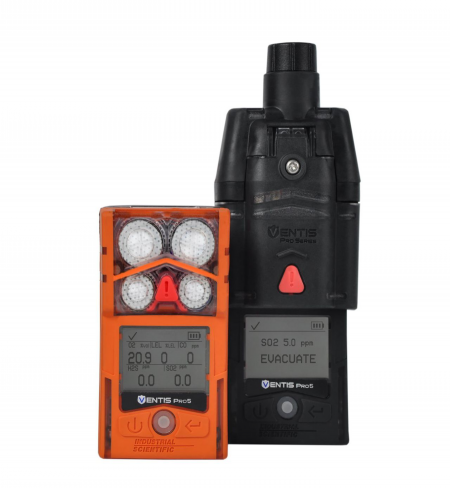
MULTI-GAS MONITOR
Detect up to five gases simultaneously with the rugged, wireless, Ventis® Pro5 Multi-Gas Monitor. With Ventis Pro5, safety goes beyond the gas detector whether you need team-based alarm sharing, remote monitoring with location details, or both. The monitor is also backed by a Guaranteed for Life™ warranty.
• Eliminate the need for two pieces of equipment by using Ventis Pro5 for personal monitoring and confined space entry.
• Train workers on one, multi-purpose gas monitor and reduce the risk and investment of having different devices in the field.
• Improve team and site safety by locally sharing alarms and gas readings between wirelessly connected Ventis Pro5 monitors.
• Get real-time location and alarm data directly from Ventis Pro5 gas monitors to a designated safety contact with the optional cellular or wi-fi battery pack.
• Reinforce safe behavior with programmable alarm action messages like “EVACUATE” or “VENTILATE” based on alarm level.
• Simplify the user experience with the ability to hide unnecessary screens based on user needs, role, industry, or site.
Sensor & Configuration Options The Ventis Pro5 offers sensor and configuration options for multiple industries and applications, including standard and non-standard 4-gas, 5-gas, and a methane IR sensor, making it a cost-effective option for personal protection and confined space applications.
LEL (CH4% Vol) LEL (Methane) LEL (Pentane)
O2 H2S Cl2 CO
CO/H2 Low CO/H2S SO2 NO2 IR
CH4 IR CO2 IR CO2/CH4 IR CO2/LEL IR HC ULP IR
CH4 ULP IR HC HCN NH3 PH3 VOC(PID)
SPECIFICATIONS
ELECTROCHEMICAL
INFRARED
PHOTOIONIZATION VOC (10.6 eV): 0-2,000 ppm in 0.1 ppm increments
LENS WIRELESS MESH NETWORK
Frequency: ISM license-free band (2.405 - 2.480 GHz)
Max Peers: 25 devices per network group
Range: 100 m (300 ft) line of sight, face-to-face
Encryption: AES-128 | Approvals: FCC Part 15, IC, CE/RED, others†
WI-FI: 802.11 b/g/n 2.4GHz wi-fi with WPA2 security
*These specifications are based on performance averages and may vary by instrument. ** Operating temperatures above 50 °C (122 °F) may cause reduced instrument accuracy. Operating temperatures below -20 °C (-4 °F) may cause reduced instrument accuracy and affect display and alarm performance. See Product Manual for details.
















